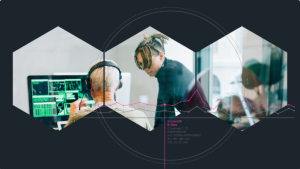Accedo社が実施した最近の調査によると、世界中の大多数のユーザーが自分が利用しているストリーミングサービスに高い期待を寄せています。再生時の画質が低すぎると感じた場合はすぐに視聴を止めると約60%が回答しています。回答者の3分の1は、インタフェースの全体的な見た目や操作感が気に入らないサービスについても同様に答えています。
考え抜かれて設計されたインタフェースは、ナビゲーションを簡素化し、コンテンツの見つけやすさを向上させ、再生機能を改良し、ユーザーを魅了するために重要な役割を果たします。さまざまなエンドユーザーの好みに応える高品質のストリーミングサービスを提供することの実現は困難ですが、サービスを成功に導くうえでは不可欠なものです。
このブログ記事では、Accedo社の運用責任者であるSteven Kopec氏と、New Relicのインダストリーソリューションリード兼M&E GMであるChris Mccarthyが、オブザーバビリティによってビデオサービスプロバイダーがエンドユーザーのストリーミング品質要件をどのように満たせるかについて説明します。
レポートをダウンロード
こちらからレポート全文を入手するか、以下をお読みいただいて2人のインサイトをご確認ください。
コンテンツプロバイダーは、高品質のストリーミングエクスペリエンスを提供するにあたってどのような課題に直面しているか
Chris(New Relic):
お客様から「テレビのような顧客体験が必要だ」という声をよく聞きます。もちろん、問題はテレビがそのために作られたインフラストラクチャを介して配信されるのに対し、ストリーミングサービスは多目的なインターネットを介して配信されることです。さらに、認証、DRM(デジタル著作権管理)、マルチCDN(コンテンツ配信ネットワーク)ルーティング、パーソナライゼーション、ターゲットを絞った広告と検証、クライアントデバイスの多様化などが重なり合い、非常に複雑なソフトウェアアーキテクチャーになります。ここまでは、コンテンツの提供についてのみ説明しており、そもそもライブコンテンツまたはオンデマンドのコンテンツを処理してCDNに配信するために何が必要かについては触れていません。
Steven(Accedo):
私もChrisの意見に同感です。ビデオストリーミングサービスは、複雑なアーキテクチャーに依存しています。バックエンド機能やAPIがフロントエンド機能と一致していない場合、この複雑さはさらに増大します。たとえば、ユーザーが特定のカテゴリで並べ替えやフィルター処理を行おうとした場合や、不完全なメタデータがクラッシュを引き起こしたり開発を遅らせたりする場合、メタデータがいつどこで欠落しているか、そのメタデータがロジックに与える影響をチームが考慮する必要があります。特定の機能を実現するためにさまざまなバックエンドを調整することが、非常に複雑になる可能性があります。
コンテンツプロバイダーにとってのもう1つの大きな懸念は、単一のエコシステム内であってもデバイスの多様性による問題が発生します。この多様化への対応により、アニメーションの改善、データポップインの削減、エラー処理やメッセージングの強化など、サービスの向上に使用できる開発サイクルが消費される可能性があります。
オブザーバビリティには何が必要か。そして、コンテンツプロバイダーはオブザーバビリティをどのように活用して、リアクティブではなくプロアクティブにストリーミングプラットフォームの問題を最小限に抑えることができるか
Chris(New Relic):
オブザーバビリティとは、アーキテクチャーのあらゆる側面が特定の時点でどのように実行されているか、それがビジネスにどのような影響を与えるかを把握することです。New Relicでは、これはイベントレベルまでドリルダウンすることを意味します。つまり、「過去30分間でバッファリングレートが3倍になりました」などの集計アラートから、「影響を受けたユーザーセッションと、リクエストデータおよびCDNログがあります」まですばやくドリルダウンして、すぐに問題に対処できるようになります。ソフトウェア開発ライフサイクル全体を通じて、オブザーバビリティを要件として組み込むことは、お客様が開発に起因する問題を発生前に特定するうえで役立つことがわかりました。もちろん、CDNがダウンするなど制御不能な運用上の問題は常に発生します。しかし、優れたオブザーバビリティプラットフォームと戦略によって問題の検出と修復にかかる時間を短縮できます。
Steven(Accedo):
コンテンツプロバイダーが成功するには、収益化と収益性が必要不可欠です。しかし、ほとんどのビデオサービスプロバイダーが直面している主な懸念は、加入者の減少につながる要因を理解するためのデータドリブンなアプローチが欠けていることです。オブザーバビリティプラットフォームを使用すると、ビデオサービスプロバイダーは、リスクにさらされている加入者の行動パターンを特定し、根本原因分析を実施して、限定コンテンツやパーソナライズされたオファーの提供など対象を絞ったアクションを実行できます。
また、コンテンツプロバイダーは、エンドユーザーに対するプラットフォームの可用性の成功を一貫して評価するために、Chrisが前述したように、オブザーバビリティプラットフォームを活用して主要メトリクス(ビデオ遅延、ユーザーエンゲージメント、コンテンツ消費パターンなど)のパフォーマンスパラメーターを測定する必要があります。
パフォーマンス問題のトラブルシューティングや対処だけでなく、ユーザー体験の最適化で、オブザーバビリティツールをどのように使用できるか
Chris(New Relic):
適切に設定されたオブザーバビリティソリューションは、集約されたタイミングメトリクスだけでなく、イベントレベルでもデータを収集します。そのため、顧客は何を見たいかをあらかじめ決めてそれをコードに記述する必要がなく、生のユーザーデータからオンデマンドでインサイトを得ることができます。New Relicは、イベントベースのモデルとスケーラブルな時系列データベースを備えているため、興味深いユーザー行動や予期しないユーザー行動を明らかにし、ユーザー体験を最適化できるアドホック分析に適しています。さらに、セッションリプレイやユーザージャーニーなどの機能により、ユーザーの行動やユーザーがクライアントアプリケーションとどのように対話するかについてのさらなるインサイトが得られます。
Steven(Accedo):
何年にもわたりUXの重要性が強調されてきたにもかかわらず、業界ではいまだにUXを完成させるのに苦労している人が多数います。運用を合理化し、ベンダーを統合することは重要ですが、こうした取り組みが最高のUX提供が損なってはいけません。ユーザーを真に理解し、ユーザーに応えるために、プロバイダーは表面レベルのUXデザインを超える必要があります。オブザーバビリティプラットフォームにより、コンテンツプロバイダーはユーザーの好み、人口統計データ、行動データに関するインサイトを得ることができ、ユーザーが求めていることをより明確に理解できるようになります。興味や場所に基づいて加入者をセグメント化およびグループ化することで、プロバイダーは特定のユーザーセグメントに厳選されたコンテンツの選択肢を提供できるため、全体的なビデオエクスペリエンスが向上します。
次のステップ
ほとんどのビデオサービスプロバイダーは、オブザーバビリティが単なる技術要件以上のものであることに同意していると思われますが、問題に積極的に対処し、ユーザーニーズを予測し、エクスペリエンスをカスタマイズするためにオブザーバビリティを活用する能力を誰もが備えているわけではありません。
New Relicがスポンサーとなっている最新のAccedo eBookをダウンロードして、オブザーバビリティへの理解を深め、ユーザー体験の低下や加入者の離脱につながる前に、データドリブンなアプローチで最適化されていないサービスパフォーマンスにどのように対処できるかを理解してください。
本ブログに掲載されている見解は著者に所属するものであり、必ずしも New Relic 株式会社の公式見解であるわけではありません。また、本ブログには、外部サイトにアクセスするリンクが含まれる場合があります。それらリンク先の内容について、New Relic がいかなる保証も提供することはありません。





